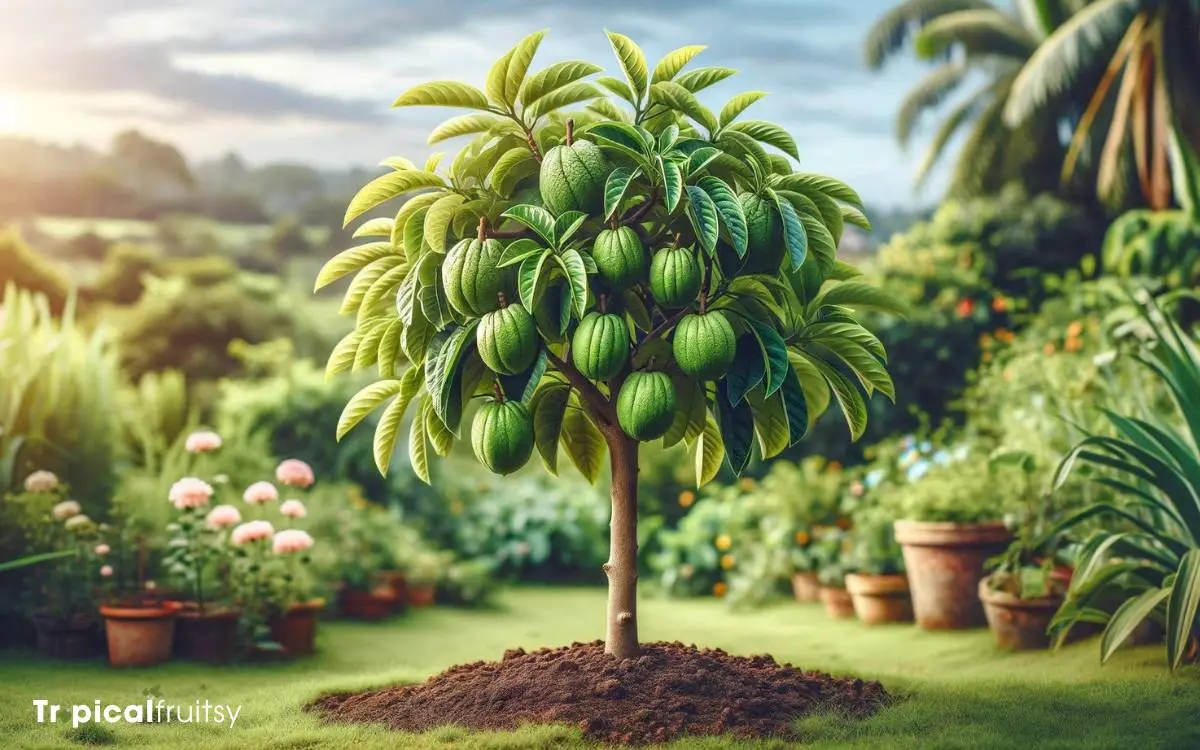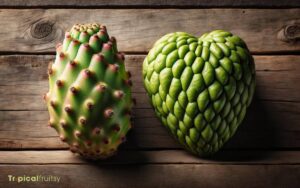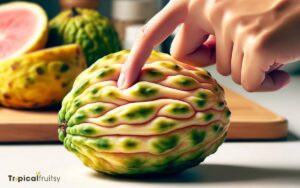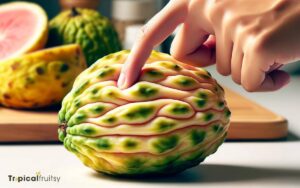How to Grow a Cherimoya Tree? 7 Easy Steps!
To grow a cherimoya tree, start by selecting a well-drained, sunny location. Plant your cherimoya in rich, loamy soil with good irrigation. Water the tree regularly, but avoid waterlogging.
Fertilize during the growing season with a balanced, slow-release fertilizer. Pruning is essential to maintain a productive tree structure and facilitate harvest. Protect the tree from frost, as cherimoya trees are sensitive to cold temperatures.
Cherimoya trees, known scientifically as Annona cherimola, thrive in subtropical climates with cool winters and warm summers.
They require specific growing conditions, including:
A cherimoya tree grown in a Mediterranean climate will likely have an abundance of fruit due to the optimal balance of cool winters and warm summers.
Cultivating a cherimoya tree involves a blend of routine care and protection from the elements, ensuring a sweet bounty of tropical fruits.

Key Takeaway
Understanding Cherimoya Basics
Cultivation knowledge is crucial when embarking on the journey to grow a cherimoya tree, as it ensures a solid foundation for the growth and fruiting process.
The cherimoya (Annona cherimola) thrives in subtropical climates, requiring well-drained soil with high organic matter. It’s sensitive to frost, so growers must understand their local climate’s limitations.
The ideal temperature range lies between 65 and 80 degrees Fahrenheit (18-27 degrees Celsius). Furthermore, cherimoya trees demand regular watering, especially during the growing season, yet they’re susceptible to root rot if waterlogged.
It’s also imperative to implement a proper fertilization regimen, as nutrient deficiencies can hinder growth and crop yield.
With these basics in mind, one can confidently proceed to choosing the right location, which is a pivotal step for successful cultivation.
Step 1: Choosing the Right Location
Selecting an optimal site is crucial for the cherimoya tree’s growth. It is important to consider the species’ need for a frost-free climate and well-draining soil.
For gardeners aiming to cultivate a thriving cherimoya tree, the following considerations are imperative:
- Climate: The location must offer a mild, subtropical climate, with temperatures rarely dropping below 25°F to avoid frost damage.
- Sunlight: Ensure the site receives full sun for at least half of the day to promote vigorous growth and fruit set.
- Soil: Opt for a spot with rich, loamy soil that has excellent drainage to prevent root rot.
- Protection: If necessary, choose a location sheltered from strong winds, which can harm the tree’s branches and disrupt pollination.
Step 2: Soil Preparation and Requirements
Preparing the soil with diligence is essential for the cherimoya tree to establish a strong root system and thrive. Cherimoya trees require well-draining soil with a pH between 6.5 and 7.6, reflecting a slightly acidic to neutral range.
Gardeners should amend heavy clay soils with organic matter like compost or aged manure to improve drainage and aeration.
A soil test can provide valuable information about nutrient levels and pH, guiding the gardener in adjusting the soil conditions appropriately.
Incorporating a balanced, slow-release fertilizer into the planting hole can give the tree a nutritional head start.
Regular monitoring and adjustments ensure the soil maintains the conditions cherimoya trees need for optimal growth and fruit production.
Step 3: Planting Your Cherimoya Tree
Once the soil is ready, plant your cherimoya tree in a hole twice as wide as the root ball and with the same depth. This ensures the roots have ample space to expand and establish themselves.
To optimize the planting process, follow these detailed steps:
- Position the tree in the center of the hole, ensuring it’s standing straight.
- Carefully spread the roots to prevent tangling and promote outward growth.
- Backfill the hole with the original soil, avoiding over-compaction, which can hinder root penetration.
- Water the tree thoroughly to settle the soil and eliminate air pockets, providing a good start for root establishment.
These steps help create an environment conducive to the cherimoya tree’s growth, fostering a strong foundation for its development.
Step 4: Watering and Mulching Techniques
How do you ensure your cherimoya tree receives the right amount of water and benefits from mulching?
For optimal hydration, monitor the soil’s moisture, watering deeply when the top few inches become dry. This method encourages deep root development. Overwatering can lead to root rot, so it’s crucial to provide well-drained soil.
Mulching plays a significant role in maintaining soil moisture and temperature regulation. Apply a 2 to 4-inch layer of organic mulch, such as straw or bark, around the base of the tree, keeping it away from the trunk to prevent fungal diseases.
This layer also suppresses weeds and gradually enriches the soil as it decomposes. With the tree’s water needs met, it’s time to focus on fertilization and growth management.
Step 5: Fertilization and Growth Management
A cherimoya tree requires balanced fertilization during its growing season to support healthy development and fruit production.
To achieve optimal growth, gardeners must consider the specific nutritional needs of the tree:
- Apply a balanced, slow-release fertilizer with equal parts nitrogen, phosphorus, and potassium in early spring.
- Incorporate additional potassium into the regimen during the flowering period to enhance fruit quality.
- Adjust the amount of nitrogen in the summer months to prevent excessive vegetative growth that can reduce fruiting potential.
- Supplement with micro-nutrients, such as zinc and iron, to address any deficiencies that may impair growth and yield.
These steps ensure the cherimoya tree receives the necessary nutrients for robust growth.
Step 6: Pollination and Fruit Set
Following fertilization, successful pollination and fruit set are critical for the cherimoya tree to produce its sweet, custard-like fruits.
Cherimoya trees have hermaphroditic flowers, which means they possess both male and female reproductive structures.
However, the male and female phases are not synchronous. Flowers first open in the female phase, and after a few hours to days, they transition to the male phase.
To ensure effective pollination, growers often resort to hand-pollination due to a lack of natural pollinators. The process involves collecting pollen from the male phase of the flower and applying it to the stigma when the flower is in the female phase.
| Stage | Description |
|---|---|
| Female | Stigma is receptive, ready for pollen |
| Transition | Flower is changing from female to male |
| Male | Pollen is released, can be collected |
Understanding these stages is essential for timing the pollination process correctly.
Step 7: Pruning and Maintenance Practices
Pruning cherimoya trees during their dormant period maximizes their health and productivity. Gardeners must equip themselves with the proper tools, such as pruning shears, saws, and gloves, to perform this task effectively.
Conducting regular health checks on the tree can preemptively identify and manage potential issues such as pests or diseases.
Optimal Pruning Season
Determining the best time to prune a cherimoya tree is crucial for its health and fruit production. It is typically done after the harvest in late winter or early spring before new growth begins.
Gardeners should adhere to a systematic approach for pruning to ensure the tree maintains optimal health and maximizes yield.
Here are the steps:
- Assess the Tree: Examine the tree structure for any dead, damaged, or diseased branches.
- Remove the Undesirables: Cut away the identified problematic branches, ensuring clean cuts to promote healing.
- Shape for Success: Thin out dense areas to improve sunlight penetration and air circulation within the canopy.
- Encourage New Growth: Trim back tips of the remaining branches to stimulate new growth and fruiting.
This practice not only maintains the tree’s vigor but also enhances fruit size and quality.
Maintenance Tools Required
To properly maintain a cherimoya tree, you’ll need a set of specialized tools for pruning and general upkeep. Essential items include sharp, clean pruning shears for snipping smaller branches and anvil pruners for thicker limbs.
For the higher and more substantial branches, a pruning saw becomes necessary, facilitating clean cuts without damaging the tree’s structure.
Gardeners should also have a sturdy pair of gloves to protect their hands from scratches and potential sap irritation. It’s crucial to sterilize all tools before and after use with rubbing alcohol or a bleach solution to prevent the spread of disease.
Additionally, investing in a high-quality ladder ensures safe reach for upper branches, completing the essential toolkit for cherimoya tree maintenance.
Regular Health Checks
A cherimoya tree requires quarterly health assessments to ensure optimal growth and timely identification of any potential issues.
Cultivators should perform these checks with a systematic approach:
- Inspect for pests and diseases, focusing on the leaves, branches, and fruit.
- Confirm the tree’s structural integrity, looking for weak or damaged limbs.
- Assess the soil moisture and nutrient levels to adjust irrigation and fertilization practices.
- Examine the canopy for dead wood or overcrowding, which necessitates pruning.
Cherimoya Where Does It Grow
Cherimoya, known for its sweet and creamy texture, often described as a blend of banana, pineapple, and strawberry flavors, is native to the Andes mountain range in South America.
It grows in countries like Ecuador, Colombia, Bolivia, and Peru. Cherimoya cultivation has spread to other parts of the world with suitable climates, including parts of California in the United States, Southern Europe, Northern Africa, and some areas in Asia and Australia.
Cherimoya trees thrive in mild climates with cool, dry winters and mild summers.
They require a well-drained soil and are sensitive to frost, which limits their cultivation to regions with specific climatic conditions. Due to these requirements, cherimoya is often found in subtropical regions with high elevations.
Conclusion
Cultivating a cherimoya tree demands precise care, from soil preparation to pollination. One intriguing fact is that cherimoya yields can reach up to 50 fruits per tree, highlighting the potential bounty of a well-tended specimen.
Gardeners must diligently manage watering, fertilization, and pruning to ensure optimal growth and fruiting.
With meticulous attention to these practices, growers can unlock the full potential of their cherimoya trees, reaping the rewards of their labor in delicious abundance.






